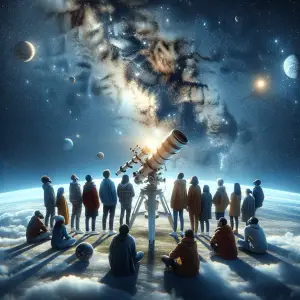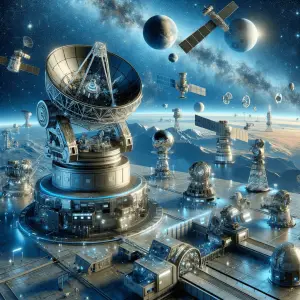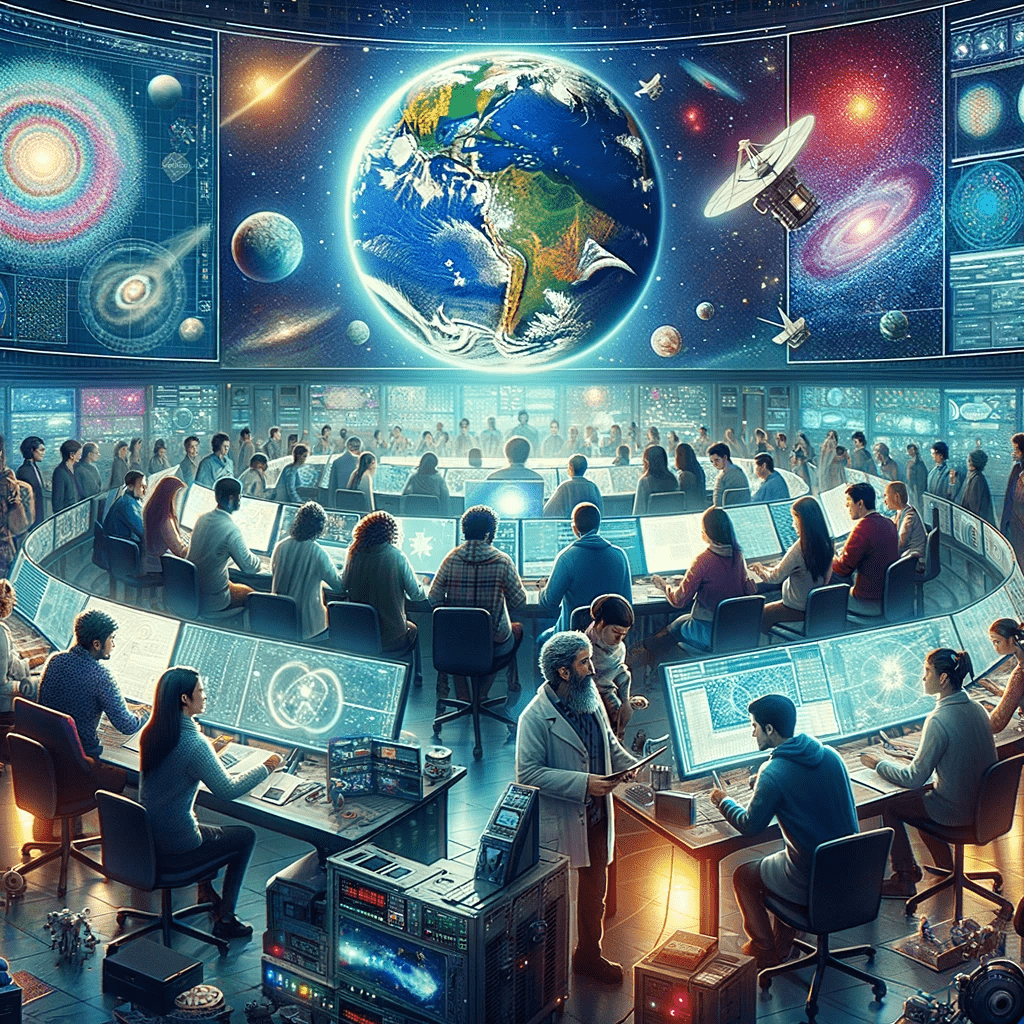Ever wondered how astronomers can confidently unravel the mysteries of the universe while bound to a single vantage point on Earth? It’s a cosmic conundrum that has perplexed minds for centuries.
In this article, we’re diving deep into the world of astronomical observations, tackling the challenges posed by Earth’s limitations, and showcasing the innovative techniques that bring clarity to our celestial inquiries.
Get ready to explore the ingenious methods and collaborative efforts that empower astronomers to make precise observations and accurate predictions, all from our tiny spot in the vast universe.
Prepare to have your astronomical curiosities satiated and your understanding of space profoundly expanded.
Understanding the Limitations of Earth-Based Observations
When we gaze up at the night sky, it’s easy to think that astronomers have a clear and unobstructed view of the cosmos. However, that’s far from the truth.
Earth’s very own atmosphere, while crucial for our survival, plays a tricky role when it comes to astronomical observations. Let’s dive in and unravel the challenges and workarounds that astronomers deal with on a daily basis.
Challenges Posed by Earth’s Atmosphere
You might not realize it, but Earth’s atmosphere is like a double-edged sword for astronomers. On one hand, it protects us from harmful radiation and space debris; on the other, it’s a bit of a party crasher for astronomical observations.
The atmosphere can distort and even block certain types of light, making stars appear blurry and less vibrant. It’s like trying to watch your favourite movie during a storm, with the signal constantly getting disrupted.
But astronomers, being the resourceful bunch they are, have found ways to mitigate these effects. They use telescopes equipped with adaptive optics that adjust in real-time to atmospheric distortions, providing clearer images of space.
It’s like having a super-smart TV that adjusts its own antenna to get the best possible signal. They’ve also placed observatories at strategic locations around the globe, including mountaintops and deserts, where the atmosphere is thinner and the skies are clearer.
Navigating Light Pollution and Geographical Constraints
Now, let’s talk about light pollution. It’s like the annoying glare on your TV screen when you’re trying to watch a movie during the day. Bright city lights can drown out the faint light of distant stars and galaxies, making them hard to observe.
Astronomers tackle this by placing observatories far away from urban areas, where the skies are darker and the stars shine brighter.
But it’s not just about escaping city lights. The Earth’s position and its rotation also play a crucial role in what we can observe. Some celestial objects are only visible from certain parts of the world, and at certain times of the year.
It’s like having a TV that can only catch certain channels depending on where it’s placed in your house.
The Impact of Earth’s Position and Movement
And speaking of Earth’s position, let’s not forget about its movement. Our planet is constantly spinning on its axis and orbiting around the Sun, creating a dynamic viewing platform for astronomers.
This movement can be both a challenge and an opportunity. On one hand, it can cause apparent shifts in the position of stars and planets, a phenomenon known as parallax. It’s like watching a movie on a moving bus, where the scenery outside seems to shift as you move.
On the other hand, Earth’s movement allows us to observe different parts of the sky at different times, providing a more comprehensive view of the cosmos.
It’s like having a TV that automatically rotates to give you the best view of the screen no matter where you are in the room.
In conclusion, while Earth’s atmosphere and position present significant challenges to astronomical observations, astronomers have developed innovative strategies to overcome these obstacles.
They’ve turned Earth into a unique and dynamic observatory, capturing the wonders of the universe from our very own backyard. So the next time you look up at the night sky, remember, there’s a lot more going on behind the scenes than meets the eye.

Leveraging Technology to Overcome Observational Limitations
In the quest to unravel the mysteries of the universe, astronomers have a secret weapon: technology. And not just any technology, but cutting-edge innovations designed to overcome the limitations of Earth-based observations.
Let’s dive into the world of adaptive optics, space telescopes, and satellite observations to see how these tools are changing the game for astronomical research.
The Role of Adaptive Optics
Imagine trying to take a picture of a distant mountain while standing in a thick fog. The image would be blurry and distorted, right? That’s exactly what happens when astronomers try to observe space through Earth’s turbulent atmosphere. But here’s where adaptive optics comes to the rescue.
This brilliant technology adjusts the telescope’s mirror in real-time to counteract the atmospheric distortion, resulting in sharper and clearer images of space. It’s like having a camera that can cut through the fog and capture a crisp photo of the mountain.
Astronomers can now observe celestial objects with unprecedented detail, from spotting exoplanets in distant solar systems to unravelling the mysteries of black holes.
Utilizing Space Telescopes
But why stop at correcting atmospheric distortion when you can completely eliminate it? That’s the idea behind space telescopes. By positioning these observatories beyond Earth’s atmosphere, astronomers get an unobstructed view of the universe. Take the Hubble Space Telescope, for example. Since its launch in 1990,
Hubble has captured stunning images of distant galaxies, nebulae, and other celestial wonders, providing invaluable data to scientists around the world.
It’s like having a front-row seat to the greatest show in the universe, with a clear view of everything from the dramatic death of stars to the birth of new planetary systems.
Satellite Observations and Remote Sensing
But the technological marvels don’t stop there. Satellites equipped with specialized instruments are also playing a crucial role in our exploration of space. These orbiting observatories can capture data and observations that are simply not possible from Earth’s surface.
They can monitor the sun’s activity, track asteroids, and even search for signs of life on other planets. It’s like having a network of spies scattered across the solar system, each one sending back valuable information to help us better understand our place in the cosmos.
In conclusion, technology is the unsung hero of astronomy, providing the tools and capabilities needed to overcome the challenges of
Earth-based observations. From the adaptive optics that clear away the atmospheric blur to the space telescopes and satellites that offer a bird’s-eye view of the universe, these innovations are opening up new frontiers in our quest to understand the cosmos.
So the next time you look up at the night sky, remember, there’s a whole arsenal of technological wonders working behind the scenes to bring the wonders of space into sharp focus.
Enhancing Observations with Computer Simulations and Collaborative Efforts
Astronomy is like a giant jigsaw puzzle, with pieces scattered all across the universe. And sometimes, no matter how hard we try, we can’t observe every piece directly.
That’s where computer simulations and collaborative efforts come into play, helping us to see the full picture and understand the cosmos like never before.
Simulating the Unobservable
Think of computer simulations as a cosmic crystal ball, allowing astronomers to peer into aspects of space that are otherwise hidden or too complex to observe directly.
These digital models help us to study everything from the formation of galaxies to the behaviour of black holes. It’s like having a time machine and a magnifying glass rolled into one, giving us the ability to zoom in on specific phenomena and watch them unfold over billions of years.
By simulating the unobservable, astronomers can test their theories, make predictions, and gain insights that would be impossible to achieve through observation alone. It’s a game-changer for astronomical studies, enhancing our understanding of the universe in ways we never thought possible.
The Power of Global Collaboration
But astronomy is not a solitary endeavour. It’s a global affair, with scientists from around the world working together to unravel the mysteries of the universe. International collaboration is the lifeblood of astronomical research, fostering a spirit of cooperation and data sharing that leads to ground-breaking discoveries.
When one observatory captures a fleeting glimpse of a distant supernova or a rare cosmic event, the entire astronomical community can come together to analyse the data and share in the excitement. It’s like having a worldwide network of detectives, each contributing a piece of the puzzle to solve the grand cosmic mystery.
Through collaborative efforts, we’re able to pool our resources, share our knowledge, and achieve a more comprehensive understanding of space.
Theoretical Astronomy: Filling in the Gaps
And then there’s theoretical astronomy, the unsung hero of the astronomical world. When direct observations fall short, theoretical astronomers step in, using the power of math and physics to interpret the data and make sense of the cosmos.
They’re like the master storytellers of astronomy, weaving together observational clues to create a coherent narrative of the universe. Whether it’s predicting the behaviour of distant stars or deciphering the signals from a newly discovered exoplanet, theoretical astronomy plays a crucial role in filling in the gaps and enhancing our understanding of space.
It’s a delicate dance between theory and observation, with each one informing and enriching the other, creating a symphony of knowledge that guides us in our quest to understand the universe.
In conclusion, the journey to unravel the mysteries of the cosmos is a collaborative effort, enhanced by the power of computer simulations and theoretical insights. Together, these tools and approaches allow us to explore the unobservable, share knowledge across borders, and fill in the gaps in our understanding, painting a richer and more detailed picture of the universe we call home.
So the next time you look up at the stars, remember, there’s a whole world of collaboration, simulation, and theoretical exploration working together to bring the wonders of space into sharper focus.
Learning from Past Successes and Looking to the Future
Astronomy is a field that’s constantly on the move, always pushing the boundaries of what we know about the universe. From celebrating past astronomical triumphs to eagerly anticipating future technologies and missions, there’s never a dull moment in the world of space observation.
Let’s take a closer look at how we’ve gotten to where we are today and where we’re headed next.
Celebrating Astronomical Triumphs
Every now and then, it’s important to take a step back and appreciate just how far we’ve come. The field of astronomy is filled with incredible success stories, where innovative observation techniques and sheer determination have led to ground-breaking discoveries.
Think of it like a highlight reel of the universe’s most awe-inspiring moments, captured for us to marvel at. From identifying new exoplanets to unravelling the mysteries of black holes, these triumphs in space study are a testament to what we can achieve when we push the limits of our observational capabilities.
They remind us that even with Earth-based limitations, the sky is not the limit; it’s just the beginning.
Upcoming Technologies and Missions
But as much as we love to celebrate the past, the future of astronomy holds even more promise. With upcoming technologies and space missions on the horizon, we’re on the cusp of a new era of astronomical observations.
Imagine telescopes that can peer even deeper into the cosmos, missions that could unlock the secrets of dark matter, or technologies that bring us closer than ever to answering the age-old question: are we alone in the universe?
The potential for further advancements in our understanding of space is boundless, and the excitement in the astronomical community is palpable. We’re not just looking up at the stars; we’re finding new ways to reach out and touch them.
The Continuous Evolution of Observational Techniques
And let’s not forget about the continuous evolution of observational techniques. Astronomy is not a static field; it’s a living, breathing entity that grows and adapts over time.
The tools and methods we use to observe the universe have come a long way from the rudimentary telescopes of the past, evolving into sophisticated instruments that provide more accurate and comprehensive knowledge of the cosmos.
This evolution is a journey of constant improvement, as we strive to gain a better understanding of the universe and our place in it. It’s a testament to the ingenuity and perseverance of astronomers throughout the ages, and a reminder that in the world of astronomy, the only constant is change.
In conclusion, whether we’re looking back at past successes or forward to future possibilities, the field of astronomy is always moving, always evolving.
It’s a thrilling ride through time and space, and the best part is, we’re all along for the journey. So here’s to the astronomical triumphs of yesterday, the exciting advancements of tomorrow, and the continuous evolution that keeps us reaching for the stars.

Addressing Misconceptions and Ensuring Data Accuracy
In the vast and intricate world of astronomy, ensuring the accuracy of our observations is paramount.
However, misconceptions can cloud our understanding, and it’s crucial to address these head-on. Let’s dive into debunking some common astronomical myths, understanding the importance of meticulous data analysis, and ensuring the certainty of our observations.
Debunking Astronomical Myths
Astronomy is no stranger to myths and misconceptions. From misunderstandings about how telescopes work to misconstrued facts about the cosmos, there’s a lot of misinformation out there.
It’s like a game of cosmic telephone gone wrong. But fear not, because we’re here to set the record straight. By providing clear, accurate information, we can dispel these myths and ensure that everyone has a solid understanding of astronomical observations.
It’s all about clearing up the confusion and ensuring that the truth shines as brightly as a supernova in the night sky.
The Importance of Data Analysis in Astronomy
But addressing misconceptions is just one piece of the puzzle. Data analysis plays a starring role in transforming raw observational data into meaningful insights and knowledge.
Think of it as the Rosetta Stone of astronomy, helping us to decode the secrets of the universe. Without proper data analysis, we’d be lost in a sea of numbers and graphs, unable to unlock the cosmic mysteries that await us. It’s a meticulous process, but it’s what turns data into discovery, and it’s absolutely crucial for understanding the intricacies of our observations.
Ensuring Observational Certainty
And then there’s the quest for observational certainty. Despite the challenges of observing space from our little blue planet, astronomers have developed a plethora of methods and techniques to ensure the accuracy of their observations.
It’s like being a detective with a telescope, piecing together clues and double-checking your work to make sure everything adds up. By rigorously testing and verifying our observations, we can achieve a level of certainty that stands up to even the most skeptical scrutiny.
It’s a commitment to precision and reliability, and it’s what makes astronomy such a trusted and respected field.
In conclusion, addressing misconceptions, analysing data with precision, and ensuring observational certainty are all critical components of accurate astronomical observations.
It’s a journey of clarification, interpretation, and verification, and it’s what allows us to explore the cosmos with confidence. So the next time you hear an astronomical myth or wonder about the accuracy of an observation, remember, there’s a whole world of data analysis and meticulous verification behind the scenes, ensuring that we’re always on the path to truth and discovery.

